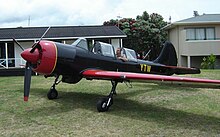
A stick shaker is a mechanical device designed to rapidly and noisily vibrate the control yoke of an aircraft, warning the flight crew that an imminent aerodynamic stall has been detected. It is typically present on the majority of large civil jet aircraft, as well as most large military planes.

China Airlines Flight 642 was a flight that crashed at Hong Kong International Airport on 22 August 1999. It was operating from Bangkok to Taipei with a stopover in Hong Kong.
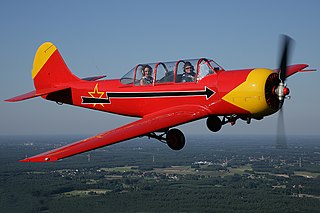
The Yakovlev Yak-52 is a Soviet primary trainer aircraft which first flew in 1976. It was produced in Romania from 1977 to 1998 by Aerostar, as Iak-52, which gained manufacturing rights under agreement within the former COMECON socialist trade organisation. The Yak-52 was designed as an aerobatic trainer for students in the Soviet DOSAAF training organisation, which trained civilian sport pilots and military pilots. Currently the Yak-52 is used in the Fédération Aéronautique Internationale (FAI) World Aerobatic Yak 52 Competition, a popular powered aircraft one-design World Aerobatic Championship.

The Beechcraft Bonanza is an American general aviation aircraft introduced in 1947 by Beech Aircraft Corporation of Wichita, Kansas. The six-seater, single-engined aircraft is still being produced by Beechcraft and has been in continuous production longer than any other aircraft in history. More than 17,000 Bonanzas of all variants have been built, produced in both distinctive V-tail and conventional tail configurations; early conventional-tail versions were marketed as the Debonair.

The Robinson R44 is a four-seat light helicopter produced by Robinson Helicopter Company since 1992. Derived from the company's two-seat Robinson R22, the R44 features hydraulically assisted flight controls and a larger engine. It was first flown on 31 March 1990 and received FAA certification in December 1992, with the first delivery in February 1993.

The Yakovlev Yak-55 is a single-seat aerobatic aircraft. Pilots flying the Yak-55 have won several world aerobatic championships.
Northwest Airlines Flight 2 was a Lockheed Super Electra aircraft, registration NC17388, which crashed into the Bridger Mountains in Gallatin County, Montana, about twelve miles (20 km) northeast of Bozeman, on January 10, 1938. All ten on board were killed in the accident, which was the first fatal crash of a Lockheed Super Electra and of a Northwest Airlines aircraft.

Mohawk Airlines Flight 40 was a scheduled passenger flight between Syracuse, New York and Washington, DC, with an intermediate stop in Elmira, New York. On June 23, 1967 it suffered a loss of control and crashed, killing all 30 passengers and four crew on board. It was the deadliest disaster in the airline's history. A valve in the auxiliary power unit had suffered a complete failure, spreading fire to the tailplane, causing a loss of pitch control.

Cubana de Aviación Flight 493, registration CU-T188, was a Douglas DC-4 en route from Miami, Florida, to Havana, Cuba, on April 25, 1951. A US Navy Beechcraft SNB-1 Kansan, BuNo 39939, was on an instrument training flight in the vicinity of Naval Air Station Key West, Florida, at the same time. The two aircraft collided in mid-air over Key West, killing all 43 aboard both aircraft.

Adam Air Flight 172 was a scheduled domestic passenger flight from Soekarno–Hatta International Airport to Juanda Airport, Surabaya. On 21 February 2007, the Boeing 737-300 operating the flight made a hard landing at Surabaya and suffered fuselage cracking in the middle of the passenger section. All six of Adam Air's remaining 737s were immediately grounded, and five of them were back in regular service later that year. This incident caused further concerns regarding the safety of flights operated by Adam Air, which had received much criticism after the 1 January 2007 crash of Flight 574.
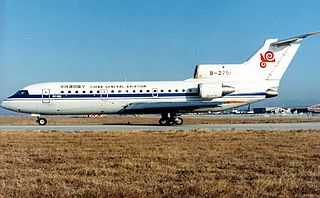
China General Aviation Flight 7552 was a China General Aviation flight from Nanjing Dajiaochang Airport to Xiamen Gaoqi International Airport. On July 31, 1992, the Yakovlev Yak-42D overran runway 06 during takeoff and impacted an embankment at 210 kilometres per hour, 420 metres (1,380 ft) from the threshold.
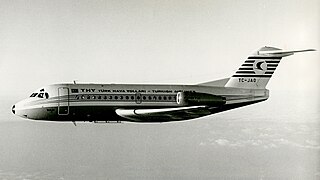
Turkish Airlines Flight 301 was a passenger flight operated by a Fokker F28-1000 Fellowship of Turkish Airlines registered as TC-JAO that crashed during takeoff at İzmir Cumaovası Airport on 26 January 1974 while en route to Istanbul Yeşilköy Airport, killing 67 of its 73 passengers and crew.

On 4 September 2010, a modified Fletcher FU-24 aeroplane on a parachuting flight from Fox Glacier Aerodrome, New Zealand, crashed shortly after take-off, killing all nine people on board.

On April 4, 1955, a United Airlines Douglas DC-6 named Mainliner Idaho crashed shortly after taking off from Long Island MacArthur Airport, in Ronkonkoma, Islip, New York, United States.

On 7 September 2011, YAK-Service Flight 9633, a Yakovlev Yak-42 charter flight operated by YAK-Service, carrying players and coaching staff of the Lokomotiv Yaroslavl professional ice hockey team, crashed during take-off near Yaroslavl, Yaroslavl Oblast, Russia. All but one of the 45 people on board were killed. The aircraft overran the runway at Tunoshna Airport before briefly lifting off, striking an antenna mast, catching fire, and crashing on the bank of the Volga river. The tragedy is commonly known as the Lokomotiv hockey team disaster.
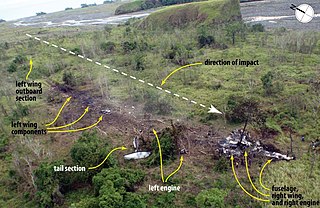
On 13 October 2011, Airlines PNG Flight 1600, a Dash 8 regional aircraft on a domestic flight from Lae to Madang, Papua New Guinea, crash-landed in a forested area near the mouth of the Guabe River, after losing all engine power. Only four of the 32 people on board survived. It was the deadliest plane crash in the history of Papua New Guinea.
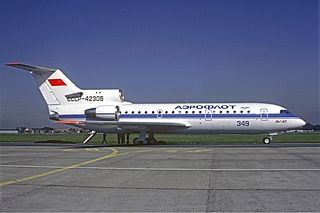
Aeroflot Flight 8641 was a Yakovlev Yak-42 airliner on a domestic scheduled passenger flight from Leningrad to Kiev. On 28 June 1982, the flight crashed south of Mazyr, Byelorussian SSR, killing all 132 people on board. The accident was both the first and deadliest crash of a Yakovlev Yak-42, and remains the deadliest aviation accident in Belarus.

On October 19, 2021, a corporate McDonnell Douglas MD-87, registered as N987AK, crashed and caught fire during take-off, 1,600 feet (500 m) from Houston Executive Airport. Those on board, 18 passengers and three crew members, were safely evacuated out of the aircraft. The aircraft was damaged beyond repair and was subsequently written-off.

The 1981 Zheleznogorsk mid-air collision was an accident involving a Yakovlev Yak-40 jet and a Mil Mi-8T helicopter, both operated by the Russian airline Aeroflot, 11 km east of Zheleznogorsk-Ilimskiy Airport, Soviet Union, on 18 September 1981. None of the combined 40 passengers and crew on either aircraft survived.
